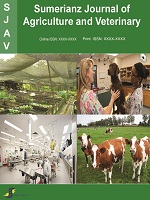Sumerianz Journal of Agriculture and Veterinary

Online ISSN: 2617-3077
Print ISSN: 2617-3131
Quarterly Published (4 Issues Per Year)
Journal Website: https://www.sumerianz.com/?ic=journal-home&journal=30Archive
Volume 2 Issue 7 (2019)
The Physical, Chemical, Organoleptic and Microbiological Quality of Meat and Meat Products: A Case Study in Gazipur district
Authors : Sadia Hossain ; Nasrin Nahar Begum ; Md Shamim Akhter
Abstract:Meat is one of the most significant foods in the diet of the vast majority of individuals. The aim of this study was to determine the physical, chemical, organoleptic and microbiological quality of meatand meat products produced by aprivate enterprise in Gazipur District. For convenience, the samples of meat were randomly collected from the enterprise. All the samples were subjected to physical and chemical quality tests consisted of temperature test, acidity (pH) test, water activity (Aw) test, total ash contents test and formalin test. For microbiological quality determination, standard plate count (SPC) and coliform count were performed while for organoleptic tests; odor, color, texture, appearance tests were conducted. In addition, the water used in the meat plant was subjected to organoleptic, physical and chemical quality tests: Odor, color, appearance,pH test, TDS test, iron test and hardness test. The results of temperature test, acidity (pH) test, water activity (Aw ) test, total ash contents test, formalin test were -3 °C, 7.6, 0.75, 0.7, nil, respectively.Standard plate count (SPC) and coliform count tests showed the result less than 30 cfu/ml, < 10 cfu/ml, respectively. Organoleptic tests results highlighting odor, color, texture and appearance were, as a whole, satisfactory. The quality parameters of the water used in the meat plant wereacceptable: pH test-6.6, TDS test-60ppm, iron test-0.1 and hardness test-45.Considering all the parameters, it can be concluded that the meat and meat products were of good quality and safe enough for the consumers. The overall results of the study suggest that the meat industry could be a promising in Bangladesh if the meat plants maintain such good enough hygienic condition.
Toxicity of Two Selected Plant Extracts on Termites, Macrotermes Spp. (Isoptera: Termitidae)
Authors : Okere C. I. ; Akunne C. E. ; Adaigbe V. C. ; Aneni T. I. ; Ogbebor C. O. ; Adeh S.
Abstract:Laboratory studies were conducted in the main station of the Nigerian Institute for Oil Palm Research to determine the toxicity of two selected plant extracts (Jatropha. curcas and Ricinus. communis) on adult soldier termites, (Macrotermes spp). The seed of J. curcas and R. communis were extracted using crude aqueous extraction and applied separately at three concentration levels of 10, 20, and 35% (w/v) each on adult soldier termites. Water (2ml) served as negative control while Cypermethrin (1%) served as positive control. The treatment was replicated four times and mortality of adult soldier termites of Macrotermes spp. was recorded at 12 and 24 hours intervals. Phytochemical analysis of the plant extracts was carried out showing the presence of tannins, alkaloids, flavonoids, saponins and phenol. The result showed 100% mortality of Macrotermes spp. on exposure to 1% Cypermethrin and 35% of J. curcas seed extract at 12hrs while exposure to 10% and 20% of J.curcas at 24hrs recorded 100% with water having 0.00% at both 12hrs and 24hrs. There was significant difference between the treatments and the control at 12 hrs. and 24 hrs. (P=0.00). The result also showed that the percentage mortality of Macrotermes spp. (100%) was recorded higher on exposure to Cypermethrin followed by 35% of R. communis seed extract (97.5%) but lowest in the water control (0.00%) at 12 hrs. Also exposure to 10% and 20% extracts of R. communis at 24hrs showed 100% mortality of Macrotermes spp. However, the effect of R. communis seed extract on the adult mortality of Macrotermes spp was significantly different between the treatments and the control at 12 hrs and 24 hrs (P=0.00). The log-probit regression analysis showed that the LC50 of J. curcas and R. communi seed extract after 12 hrs was found to be 9.568% and 8.451% respectively. The study showed that J. curcas and R. communi seed extract have the ability to control adult termites of Macrotermes spp. and can serve as bio-control agents.
Menu Script Field: Response of Soybean to Water Deficit and Spider Mites During Seed Filling Stage
Authors : Natalia Georgieva ; Ivelina Nikolova
Abstract:Morphological, physiological and biochemical responses of soybean were investigated under influence of water deficit and spider mites, imposed during seed filling stage. The pot experiment was conducted under greenhouse conditions and included 3 factors: factor A - mode of irrigation (water deficit and irrigation), factor B - mites (presence or absence of mites) and factor C - imidacloprid (with and without imidacloprid treatment). Imidacloprid was used due to its protective effect in conditions of abiotic and biotic stress. The results showed that the interaction of the stress factors led to a reduction in the leaf area (46.7%), relative water content (17.9%), total content of photosynthetic pigments (39.8%) and to an increase in density of leaf trichomes (23.1%) and content of water-soluble sugars (128.6%). Soybean aboveground biomass was characterized by reduced protein content (by 17.6%) and in vitro digestibility of dry matter (7.2%) and slightly increased synthesis of NDF, ADF and cellulose. Negative consequences of the mites in conditions of both modes of irrigation (+ WD, -WD) showed that they are more pronounced under water deficit than in irrigation regarding plant leaf area, total pigments and biomass protein conten. Treatment with imidacloprid had a positive effect on the stressed plants (+ WD + M + I). It favored the synthesis of water-soluble sugars, leaf pigments and basic parameters such as CP, CF and NDF in the soybean biomass as well as increased the size of leaf area. In future, more investigations are needed to study the effect and the possibility to use different substances to minimize the consequences of biotic and abiotic stress.


